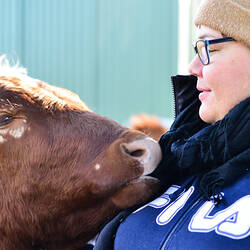Summary
This image is one of five photographs of Sarah Parker at Tatura taken by Tagen Baker on 11 August 2016 as part of The Invisible Farmer Project.
This particular image shows Sarah Parker on her farm, preparing to milk a cow within a containment area.
Originally from the inner city of Brisbane, Queensland, Sarah Parker admits to growing up without any exposure to the agriculture and farming industry. However, with her husband Brian coming from a strong farming background, he was able to gently guided her into the farming lifestyle. Now with 140 acres of irrigated property, they co-own and operate Glencliffe: a successful dairy farm of approximately 110-130 cows that supplies milk to a boutique Italian cheese company. Sarah speaks passionately about climate change, irrigation and farming practices, and the importance of community support and connectivity within the farming industry.
The Invisible Farmer Project was the largest ever study of Australian women on the land, uncovering the histories and stories of Australian women in agriculture. It began as a pilot project (2015-2016) and evolved into a three year (2017-2020) nation-wide partnership between rural communities, academic, government and cultural organisations, funded by the Australian Research Council.
Description of Content
Woman standing near the hind leg of a cow within a containment area.
Physical Description
Digital colour photograph
Significance
As a visiting research associate for Museum Victoria, and a PhD student in Utah State University's Department of Environment and Society, Tagen Baker had the opportunity to explore the diverse landscape of Victoria and interview and photograph women farmers as part of The Invisible Farmer Project-to learn from them about their histories, responses to climate change, and how they adapted their agricultural practices to sustain themselves and their families. Tagen wanted to know how their experiences have been similar or different to women in her home state of Idaho, USA. How have women been key agents of change embedded in their environments? How do women farmers provide unique perspectives and contributions to the futures of agriculture and to their communities?
As part of her research process, Tagen asked several women farmers if she could photograph them with an item of value. This item opened up a unique opportunity to communicate and learn about the farmers' lives. The item chosen was not only symbolic as a physical item of value, tangible and necessary, but a portal into a storytelling journey, a symbol of their rich and unique life experiences.
More Information
-
Collection Names
-
Collecting Areas
-
Photographer
-
Format
Digital file, Colour
-
Classification
-
Category
-
Discipline
-
Type of item
-
References
[Link 1] Last viewed: 6.4.17.
-
Keywords
Women Farmers, Women in Agriculture, Women's Issues, Women on Farms, Rural Women, Agriculture & Farming, Farmers

